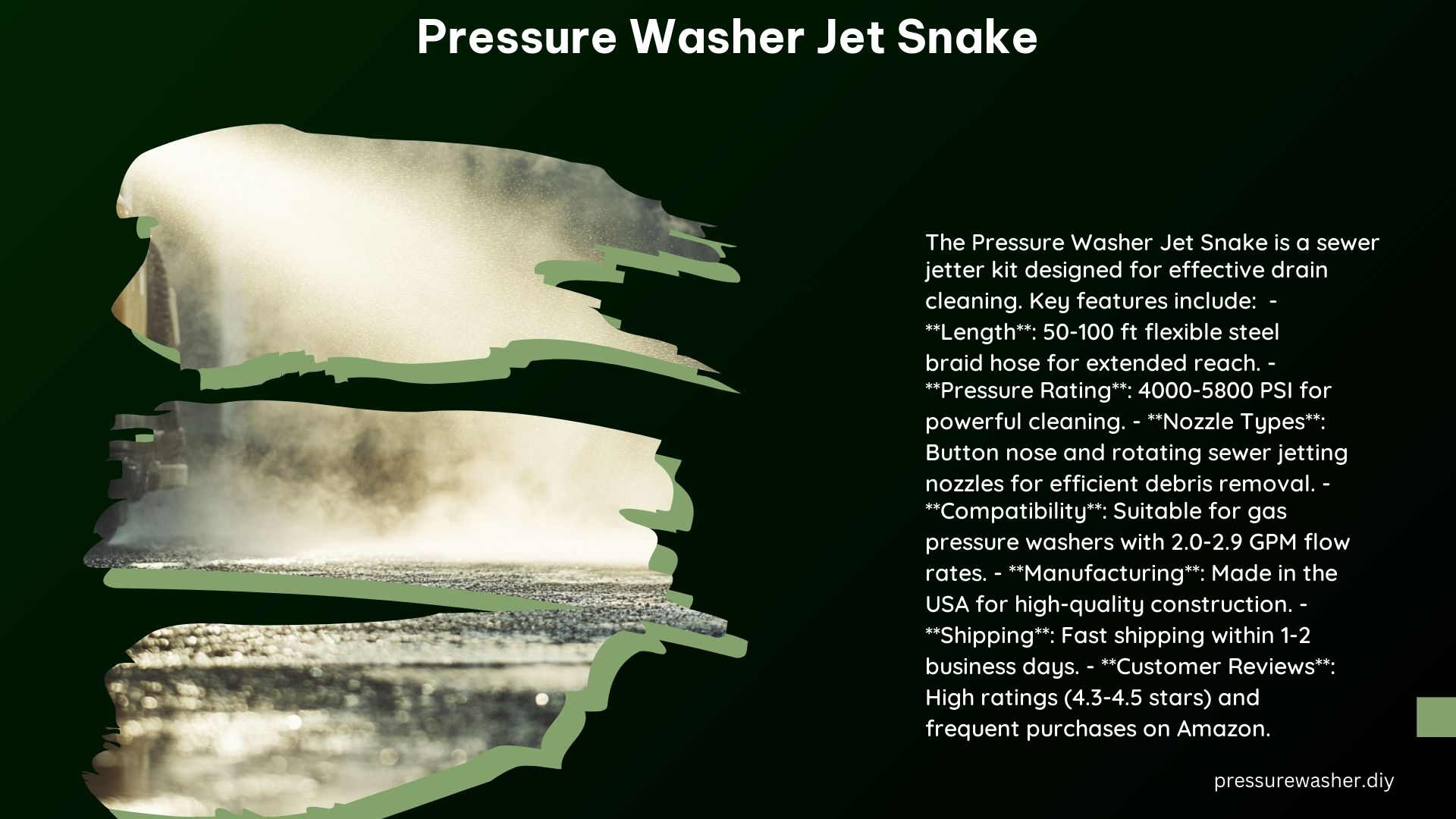The Pressure Washer Jet Snake, also known as an electric sewer jetter, is a specialized tool designed for cleaning clogged drains and sewers. It is typically used in conjunction with an electric pressure washer, which provides the necessary power to force water through the jet snake and dislodge stubborn blockages.
Benefits of Using a Jet Snake with an Electric Pressure Washer for Drain Cleaning
- Effective Cleaning: The high-pressure water jet from the pressure washer, typically ranging from 3,000 to 5,800 PSI, combined with the specialized nozzle on the jet snake, can effectively break down and remove even the most stubborn blockages in drains and sewers. The flow rate of the water jet can range from 1.2 to 4.0 GPM, ensuring maximum cleaning power.
- Easy to Use: The jet snake, with its flexible hose length of 50 to 100 feet, is designed to be easy to maneuver and insert into drains, making it a convenient tool for both professionals and DIY users. The various nozzle types, such as button nose, rotating, or needle nose, allow for targeted and efficient cleaning.
- Cost-Effective: Using a jet snake with an electric pressure washer can be more cost-effective than hiring a professional plumber or using specialized drain cleaning equipment, especially for homeowners and small businesses.
- Versatility: Jet snakes can be used for a variety of drain cleaning tasks, from residential to commercial applications, making them a versatile tool in any plumbing or maintenance arsenal.
How to Choose the Right Sewer Jetter Kit for Your Electric Pressure Washer

- Compatibility: Ensure the sewer jetter kit is compatible with your electric pressure washer’s specifications, such as PSI and GPM ratings. Mismatched equipment can lead to suboptimal performance or even damage.
- Length and Flexibility: Choose a kit with a hose length suitable for your needs, whether it’s a 50-foot or 100-foot model. The flexibility of the hose is also crucial for easy maneuverability and access to hard-to-reach drains.
- Nozzle Type: Select a kit with a nozzle type that suits your specific cleaning needs. Button nose nozzles are ideal for general drain cleaning, while rotating or needle nose designs can be more effective for tackling stubborn blockages.
- Material and Durability: Opt for a kit with a durable, high-quality hose and nozzle that can withstand the rigors of regular use. Flexible steel braid or other reinforced materials are preferred for their strength and longevity.
Technical Specifications of Pressure Washer Jet Snake, Electric Sewer Jetter, Drain Cleaner, Sewer Jetting Nozzle, High Pressure Water Jet
| Specification | Range |
|---|---|
| Pressure Rating | 3,000 to 5,800 PSI |
| Flow Rate | 1.2 to 4.0 GPM |
| Hose Length | 50 to 100 feet |
| Nozzle Type | Button nose, rotating, needle nose |
| Hose Material | Flexible steel braid, reinforced polymers |
DIY Tips and Considerations
- Safety Precautions: Always wear protective gear, including gloves and safety glasses, when using a pressure washer and jet snake. The high-pressure water jet can be dangerous if not handled properly.
- Proper Technique: Use the jet snake at the correct angle and with the appropriate amount of pressure to avoid damaging pipes or the jet snake itself. Improper use can lead to costly repairs.
- Regular Maintenance: Regularly inspect and maintain your pressure washer and jet snake to ensure optimal performance and extend their lifespan. Clean the nozzle, check for any wear or damage, and follow the manufacturer’s recommended maintenance schedule.
Reference Links
- Pressure Washer Jet Snake with Rotating Jetting Nozzles
- 50-Ft Needle Nose Drain Cleaner for Electric Pressure Washers
- How to Use a Pressure Washer Jet Snake to Clean Drains
By following the guidelines and technical specifications outlined in this comprehensive guide, you can effectively utilize a Pressure Washer Jet Snake to tackle even the most stubborn drain and sewer blockages, saving time and money while ensuring a thorough and efficient cleaning process.
